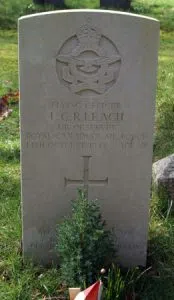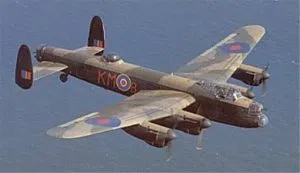
Leonard Leach was born in Osaquan, Ontario on 11th November 1920 which was a sawmill community. He was the son of Charles and Hilda Annie (nee Weston) Leach.
The sawmill community disbanded in the early 1930’s and he and his family moved to Dryden where he finished his schooling and later was working in a bank when he enlisted into the RCAF in October 1940 in Fort William, Ontario. He completed his basic training in Canada and was awarded his observer’s half-wings on 2nd August 1941 and was then granted a commission to the rank of P/O on 1st September 1941.
He was posted overseas in December 1941 and continued his training at 9 (O)AFO beginning 10th March 1942 and 16 OTU beginning 4th May 1942. He was then posted to 61 Squadron on 11th July 1942. His hometown newspaper, the Dryden Observer, made mention on 7th August 1942 that on 3rd August 1942 he took part in a raid over Dusseldorf. “All of the nine Canadians were pleased with results and expressed joy in being able to make the trip over Germany” it stated, and “Of almost an hour’s duration, the attack ruined about half of the munitions-making city” says the report.
He may also have spent a short period of attachment to 44 CU, which was 44 Squadron’s conversion training unit. While at 61 Squadron he had become the regular navigator of S/Ldr Peter Casement DSO DFC & Bar (44188).
Flying Officer Leach was killed 14 October 1942 when his damaged Lancaster bomber crashed into a hill in Yorkshire, England.
The crash of Lancaster W4233 is recorded with the note that the crew’s regular navigator was ill and F/O Leach volunteered to talk his place. The Lancaster was one of 288 bombers that attacked Kiel. The aircraft was hit by flak, but managed to get back to England.
The Lancaster was damaged by flak over Germany which damaged some of the navigation equipment and flying instruments. In the early hours of 14th October 1942 on the return leg of the flight the crew of this aircraft became lost due to poor weather, and they flew too far north of their Lincolnshire base and over the North Yorkshire Moors. The aircraft was circling to obtain a position fix but was not flying high enough when it crashed into a fairly flat section of moor at just before 01.00hrs while flying through poor weather. The aircraft caught fire on crashing and would eventually burn itself out. Whilst there is no evidence to prove it, it seems likely that all the survivors either escaped on their own accord or were helped from the burning aircraft by fellow airmen with possibly those who would later be confirmed dead being also dragged out before fire took over the aircraft completely. The navigator on this flight (F/O Leach) volunteered to fly with this crew on this operational flight after the crew’s regular navigator was unable to make the flight as he was sick. The replacement navigator was sadly one of those killed in the crash.
The Pilot also died a few days afterward, but all other crew members survived.
Leonard Leach’s uncle Mr L C Weston lived in Liss, Hampshire, England and is probably why his grave is in nearby Millard Churchyard, Sussex.
Leonard Leach is buried in St. Luke’s Churchyard, Milland, West Sussex
He was 21 when he was killed. (Lancaster bomber, Leonard’s grave marker)
All information and images courtesy of Spuro Sourtzis. Much information was provided about Leonard from a book that Jock Ferguson’s wife Leila (Wilson) Ferguson wrote. The image of Leonard’s gravesite is taken by Spuro Sourtzis when he visited the gravesite in England in 2011.
Visit our entire “Remember Our Vets” album at: https://www.ckdr.net/remember-our-veterans/










